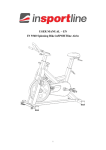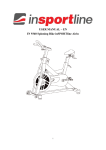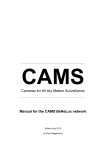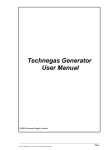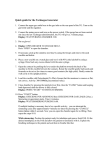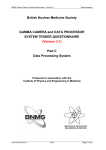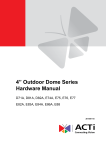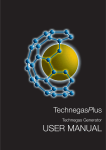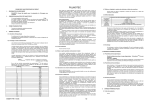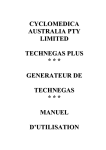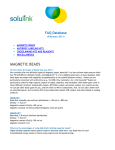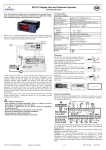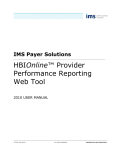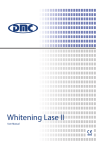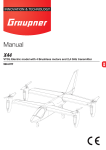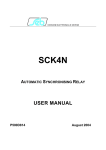Download Crucible V6/N1.indd
Transcript
CRUCIBLE THE CYCLOMEDICA NUCLEAR MEDICINE VOL 6 / NO. 1 - FEBRUARY 2013 Lung Disease COPD & Smoking & Technegas – from Man to Mouse T There is increasing interest in how V/Q SPECT/CT might be able to categorise levels of pulmonary dysfunction much more sensitively than conventional spirometry testing. The point is the presumption that the pathology of early stages of COPD is reversible. In our newsletter of May last year, the work of Professor Bajc’s group was reported where they recommended “V/[Q] SPECT can also be used to categorize the severity of functional changes in COPD as mild, moderate or severe”. Then in our December issue a critique of a paper using respiratory gated CT images in an attempt to quantify levels of COPD via a “parametic response map” prompted me to suggest that respiratory gated Technegas images might become a more sensitive index yet. “. . . . . spirometry insensitive to early disease. “ Now, an important report of some fundamental experimental work has just appeared, seeking to measure lung dysfunction in mice exposed to cigarette smoke. The authors state in the introductory remarks “...spirometry cannot detect the impact of small-airIN THIS ISSUE COPD & Smoking & Technegas 1 Comment 2 Spectlung / Back Issues 2 Japanese Opportunity 2 Tech Tips 3 Technegas Generator - FDG / Posijet 4 way obstruction until it has developed considerably, making spirometry insensitive to early disease. Further, spirometry does not differentiate the varying pathologies, such as small-airway obstruction and emphysema, associated with COPD” . This was part of their rationale for exploring the value of V/QSPECT for this purpose. [Detection of Lung Dysfunction Using Ventilation and Perfusion SPECT in a Mouse Model of Chronic Cigarette Smoke Exposure. Jobse BN, Rhem RG, Wang IQ, et al. J Nucl Med 2013; 54:1–8]. “. . . . clinically useful data . . . . . “ Again, Technegas was the ventilation agent used by this group from McMaster University in Canada. They examined the effects on the V/Q images of mice exposed to cigarette smoke over either 8 or 24 weeks, and these studies included respiratory gated CT to enable accurate voxel localisation. Their data clearly showed a response to cigarette smoke even in the 8 week exposure group. Once again, in moving up from mouse to man, it would seem that respiratory gated ventilation imaging alone should create a distribution of ‘voxels’ leading to clinically useful data reflecting the functional state of the person’s lungs. At this point it might be useful to reintroduce “Pertechnegas” as a potentially valuable tool measuring alveolar-capillary membrane permeability directly. It effectively mimics inhaled Pertechnetate aerosol, but with the added significant bonus of an initial particle size orders of magnitude smaller and an achievable specific activity concentration allowing a full dose to be inhaled in a single breath. It has already been clinically proven in assisting with the diagnosis of fibrosing alveolitis. The half-time clearance(T1⁄2) in those patients drops to around 3.5min from the normal value of 5-7min. It was also shown to be an early indicator of the onset of “radiation pneumonitis”, generating a whole lung increased permeability following localised radiotherapy to a small portion of the lung. It is known in smokers that the T1⁄2 drops to 2.5min. It would be an important social finding to see how quickly the T1⁄2 drops in the mice exposed to cigarette smoke, and when, or if, it recovers on normal air breathing. It might be considered too much to ask non-smoking volunteers to attempt this manoeuvre, but the results could be yet another tool for the anti-smoking cause – apart from any clinical worth. More details on Pertechnegas can be found on the Technegas Academic website: http://jcsmr.anu.edu.au/research/research-facilities/technegas Bill Burch Bill Burch: who ‘discovered’ what he named Technegas in 1984 and developed it through the John Curtin School of Medical Research (JCSMR) of the Australian National University (ANU) where he was a Visiting Fellow from 1976-2008.” COMMENT A common theme in the past few newsletters has been the discussion on the use of Technegas in C.O.P.D. While the interest in Australia has been ‘lukewarm’, in many countries where the incidence of C.O.P.D. is very high, there is mounting support for studies which explore this potential use of Technegas. In collaboration with our colleagues overseas, Cyclomedica is currently developing protocols which it is hoped will shed more light on this indication. I would also exhort you to send in those ‘interesting’ cases you may have come across while scanning for P.E. diagnosis in your patients particularly those negative on CT but shown to be positive with Technegas. We are interested in expanding out teaching case files so that physicians around the world can benefit from your experience. The best will be published in the Crucible and $150.00 paid to your nominated recipient. Ultimately, the cases will be able to be viewed on our website: www.spectlung.com and hopefully provide a useful tool for physicians and technologists alike. For those of you with ancient Technegas generators, how about considering an upgrade to the Technegas Plus generator? We can offer you a generous trade-in deal to make the decision more affordable. Please be aware that a price rise will occur on April 1st, 2013 as outlined in a letter sent to you recently. This is the first increase in 3 years and it is anticipated, barring some extreme unforseen circumstance, that prices will be held firm for the next 3 years. Enjoy the read. Charles Charles Buttigieg Asia-Pacific Marketing & Sales Mgr Cyclomedica JAPANESE LANGUAGE OPPORTUNITY Anyone out there in nuclear medicine land who speaks Japanese fluently? We are looking for someone who is technically conversant with the Technegas Generator to assist, on an intermittent basis, with our ‘resurrection’ of Technegas in Japan. At last count, Cyclomedica had over 100 Technegas Generators in hospital departments in Japan. Only about 5 of these departments curremtly use the technology on a regular basis. Cyclomedica Service Manager, Richard Gotch and myself intend to ‘relaunch’ Technegas in Japan but we need a competent Japanese translator to effectively relate our message to the Japanese medical personnel. In addition to training on the operation of the Technegas generator, there will be the need to translate brochures and promotional material as well as to be conversant with use of Technegas in the diagnosis of respiratory diseases such as Pulmonary Embolism, C.O.P.D., etc. If you think you can help and wish to discuss further, please call Charles Buttigieg on +61 (0) 418 285 048. ‘SPECTLUNG’ SITE Cyclomedica sponsor a website devoted the Spect Imaging. The site provides a balanced and factual information source for all aspects of lung imaging including many Case Study examples of PE detection, Literature, Imaging Issues, Diagnostic Options, GP Info and Links to other sites. The Spectlung site is becoming the goto site for lung imaging. Visit - www.spectlung.com And keep the site bookmarked to see regular updates. BACK ISSUES Like to catch up? We have a limited supply of back issues of ‘The Crucible’ in our warehouse. They cover a wide range of topics and information pertaining to Spect Imaging, Technegas and Technegas Generators, maintenance and correct procedures and similar topics. As well you’ll find past literature reviews and a good selection of Case Studies that can add to your depth of knowledge. Drop an email to [email protected] and I’ll arrange a selection to be forwarded to you. Medical Information and Adverse Reaction Reporting Cyclomedica provide distributor and customer support with medical information queries on the products. Customers are advised to initially contact their local distributor, or they may contact Cyclomedica Australia direct using the contact details below. If you wish to report an adverse reaction to the product this can be done using the same contacts details. Telephone +61 (0)2 9541 0411 Facsimile +61 (0)2 9543 0960 or Email: [email protected] TECH TIPS Keeping your TechnegasPlus Generator running smoothly. 1) House-keeping. First thing in the morning, prior to preparing the generator for a new day, empty the ash tray of broken crucibles. This keeps the generator drawer cleaner and reduces the possibility of crucible fragments shorting out the pedestals, thereby reducing the Technegas yield. A dirty drawer can also lead to fragments of crucible getting caught in the generator door track and preventing complete closure of the drawer. Error messages such as “gas leak” may occur and the Technegas generator will not work. Daily preventive cleaning, which takes only a few minutes, will lead to fewer problems in the long run. 2) Replacing Contacts. Contacts MUST be replaced every 50 burns as prompted by the Technegas generator. There is a good reason for this which relates to the Technegas generator operating at optimal efficiency resulting in the production of good Technegas yield. When the Contacts are replaced they must be tightened to secure them in place so they cannot be removed by hand. If this does not happen error messages will occur and the generator may not operate optimally as the appropriate electrical contact to generate the Technegas may not occur. 3) Daily Technegas Operation. The Technegas generator should be plugged in first thing in the morning and turned on during the working day. This is sufficient to charge the main battery. It should be turned off at the end of the day and NOT left on overnight. Nor should it be left on over the week-end. If the Technegas generator is left continually on there is a possibility that spikes in the power grid may affect the Technegas generator resulting in it failing to operate correctly. 4) Replacing Crucibles. A set of forceps is provided to assist in inserting carbon crucibles prior to generating Technegas. The carbon crucible should be inserted as demonstrated in the user manual AND Technegas generation DVD (both available on request). Use of the forceps provided to install the crucible assures that the appropriate electrical contact for the generation of Technegas is made. The forceps should be used to rock the crucible backward and forward thereby seating it into position between the contacts. A squeaking sound will be evident which indicates successful positioning of the crucible. If installed by hand there is little or no feed-back. Experience from the field has demonstrated that this is a very important element in the production of Technegas. To reiterate: Proper seating of the crucible between the contacts as demonstrated by a squeaking sound upon rocking the crucible back and forth USING the forceps will lead to successful generation of Technegas. Richard F Gotch Global Service Manager. Cyclomedica Australia P/L. Mobile +61 (0) 418 203 629 TechnegasPLUS FDG + Posijet Total control - the power, convenience and precision of bulk dose operations Cyclopet FDG - No compromise Load one bulk FDG dose Minimal exposure to patient or operator Completely manoeuvrable move to the patient Best agent for V/Q SPECT Internal power no need for power points • Draws up patient dose for injection exact dosage • • • • • Proven diagnostic accuracy - especially in presence of COPD No adverse events reported in >21⁄2 million studies; 53 countries No exclusion criteria; neonates to frail-aged 1-3 breaths for full dose Non invasive Low radiation burden compared with CTPA* Connects to patient records Completely current files Patient dosage printout Stays with patient for confirmation Step by step touch screen Added safety in operation Manual injection Added asssurance of cannula placement If you have a PET facility or contemplating one, call to discuss your FDG supply and mobile injector options. * About 1/7th of breast tissue exposure CURRENTLY AUSTRALIA ONLY Contact your nearest office ASIA / PACIFIC / STH AFRICA - Cyclomedica Australia - [email protected] Ph: + 61 2 9541 0411 Fx: + 61 2 9543 0960 Contact - Charles Buttigieg Ph: + 61 2 9541 0411 M: +61 (0)418 285 048 E: [email protected] EUROPE / MIDDLE EAST / NTH AFRICA - Contact Mr Bjorn Altmann - [email protected] Ph: +49 (0) 5341 550802 Fx: +49 (0) 5341 55803 CANADA - Cyclomedica Canada - [email protected] Ph: +1 905 319 9610 Fx: +1 905 319 0497 Contact - Lynn McLauchlin Ph: +1905 690 0345 Fx: +1905 690 0553 LATIN AMERICA- Cyclomedica Latin America - [email protected] Ph: + 54 11 4585 9172 Fx: + 54 11 4586 0251 Contact - Martin Lema Ph: + 54 911 5174 1639 GERMANY - Cyclomedica Germany - [email protected] Ph: +49 (0) 5341 550802 Fx: + 49 (0) 5341 55803 Contact - Bjorn Altmann NUCLEAR MEDICINE NUCLEAR MEDICINE





